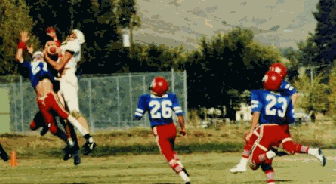|
implementing his strategic plan. During the game the coach makes tactical adjustments within the limits of his strategic plan. Such tactical adjustments may be as simple as going more with a passing attack due to his opponents strong defense against the run. In other cases the opposition may force You to limit your game to the running of less complicated quick plays by employing an aggressive rushing defense. Any adjustment you make during a game must be due to a tactical decision. You identify a threat, or opportunity, consider your options, then make a reactive change to your, game conduct. Even in the case of employing your contingency plan, you are using tactics. The only difference is that your, contingency plan exists outside the normal strategic direction of your GAME PLAN.
There are three types of tactical direction used in football, and available to the coach. These are NORMAL DIRECTIVE, AUDIBLE OPTION, And DIRECTIVE CONTINGENCY. I have already touched on two of these but it is necessary to outline all three to ensure their importance.
NORMAL DIRECTIVE. Normal tactics are employed by the coach as directives,and are an ordinary part of game conduct. This type of tactical conduct is based on actual, or perceived threats, and weaknesses in the game conduct of your, opposition. The employment of normal tactics must be kept within the limits of your game plan, only running plays that are well suited to current situational perspectives.
The use of tactics in football is an absolute requirement. Every coach must develop his tactical abilities, or he will not be effective.
AUDIBLE OPTION. The audible is a specified play, or group of plays, linked to an audible code reference.
The tactical use of the audible is employed within the limits of your game plan. The difference is that the control of game conduct is momentarily given to the quarterback.
Some coaches employ an audible option to many of their plays. This allows an effective tactical advantage since it allows the team to adjust their plays to sudden shifts by the opposition.
Often high school coaches are afraid to give their, team the option of using the audible. Usually this is because the coach is afraid of giving up the control of the game but sometimes it is simply a lack of confidence in the quarterback. The coach who wishes to include the option of using the audible, may get over his misgivings by doing two things. One. Fully indoctrinate your quarterback in the purposes of specific plays. Two. attach an advisory to the plays you call during the conduct of the game. An advisory being one or two words to let the quarterback understand the reason you made a specific call. Your advisory should Work like this, ("secondary shallow" pass play # 1 deep.) In this case your Q.B. would understand that the coach called the play because he saw that the opposition's defense was arranged with a shallow secondary. If after the play was called, the opposition's secondary was no longer arranged shallow, the Q.B. could audible a different play if he saw fit to do so.
CONTINGENCY. The contingency plan exists outside the normal strategic game plan, and infers a major shift in the conduct of the game.
Contingency plans are usually listed as an annex to the normal game plan. They are devised due to a realized weakness or strength on the part of the team.
As a contingency, you might shift from a power, I based game plan to a run And shoot based game plan.
In order to have the capability to make major shifts in your game conduct such as the one mentioned Previously. You have to practice for that eventuality even though you may never intend to make such a change unless your current situation is hopeless under your normal game plan.
|
|
